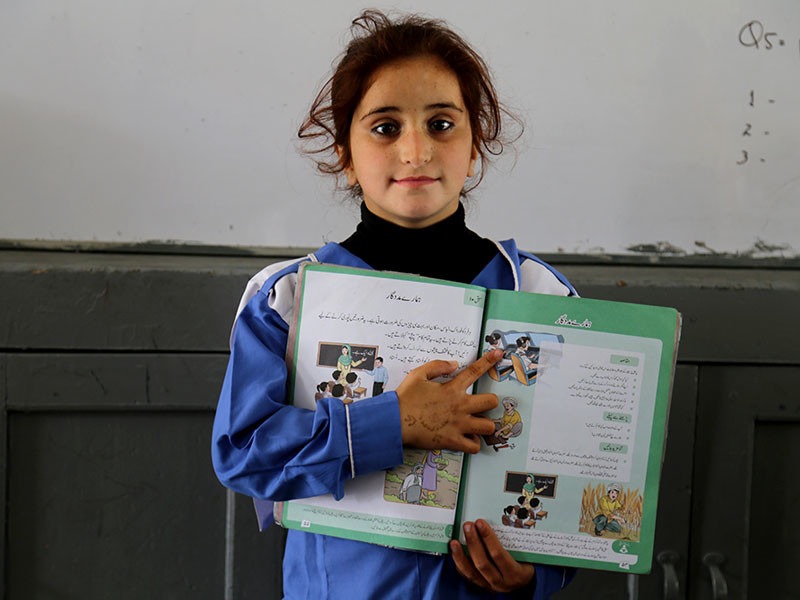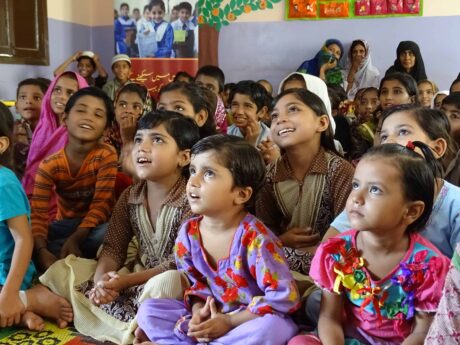Quando Aaliya, de 8 anos, lê sua nota 2 livro didático, ela vê um futuro de oportunidades pela frente. Seu capítulo favorito se chama “Pessoas que nos ajudam” e, enquanto ela folheia as páginas, ela vê homens e mulheres trabalhando lado a lado em profissões interessantes. Aaliya sonha em voar para o céu e se tornar piloto como a mulher ilustrada em seu livro.

Este aumento da representação de género nos manuais escolares é um fenómeno recente no Paquistão, e pode ter um impacto profundo.
Mulheres e meninas no Paquistão enfrentam uma batalha difícil dentro e fora da sala de aula. Um mero 43.4 por cento das meninas chegam à escola secundária e apenas 25 por cento da força de trabalho total é composta por mulheres. Aumentar estes números pode ajudar a fazer progressos em todo o país em questões como o desenvolvimento económico, a saúde das crianças e a mudança de crenças sobre o papel das mulheres na sociedade.
Como parte das reformas de leitura, o Ministério da Educação Federal e Treinamento Profissional revisou recentemente os livros didáticos de idiomas que agora estão sendo usados em todas as escolas públicas do Território da Capital Islamabad.
O Projeto de Leitura do Paquistão prestou assistência técnica às contrapartes do governo no processo de revisão para garantir a integração das habilidades de leitura e a igualdade de gênero nos livros didáticos recentemente desenvolvidos.
Como resultado, representação feminina na série 1 Os livros didáticos em urdu aumentaram em conteúdo (de 33 para 49 por cento), ilustrações (de 14 para 47 por cento) e em papéis principais (de 27 para 44 por cento). Nota 2 livros didáticos tiveram ganhos semelhantes.
“Esses materiais de aprendizagem são muito mais inclusivos do que os recursos anteriores,” explica o Dr.. Shaheen A. Xá, o Diretor de Gênero do projeto, ao avaliar os livros didáticos revisados através de uma lente de gênero.
Observou-se que, em geral, os livros didáticos no Paquistão ainda mostram preconceitos de gênero em favor dos homens, proporcionando maior representação aos homens, especialmente em posições de liderança, ilustrações, esportes, ocupações e a maioria mostra homens e mulheres em papéis estereotipados.
Nabila Kousar – diretora assistente de escola pública que orienta professores treinados pelo Projeto de Leitura do Paquistão – tem o prazer de ver o aumento da inclusão e da diversidade nos livros didáticos revisados. Ela acredita que as mensagens mais importantes do livro são aquelas que incentivam um mundo pacífico e respeitoso., especialmente para minorias e mulheres. Kousar diz que as imagens de mulheres em posições de liderança nos materiais incentivam as meninas a se prepararem para papéis de liderança no futuro.
Aumentando a escala dos livros didáticos inclusivos
O Projeto de Leitura do Paquistão, financiado pela Agência dos Estados Unidos para o Desenvolvimento Internacional, é implementado pelo Comitê Internacional de Resgate (IRC) em parceria com Creative Associates International, World Learning e IRM em todo o Paquistão.
A data, O Projeto de Leitura do Paquistão alcançou 1.38 milhões de estudantes e treinados 25,049 professores no ensino de leitura, dos quais 48 por cento são alunas e 40 por cento são professoras beneficiárias. Também desenvolveu e distribuiu 5.3 milhões de novos materiais de aprendizagem de leitura em todo o Paquistão para professores, estudantes e funcionários da educação em urdu, Sindi, pashto, Línguas Balochi e Brahui para leitores do ensino fundamental.
Dr.. Ijlal Hussain, o Vice-Chefe do Partido do Projeto, vê as mudanças nos livros didáticos como um marco importante.
“As políticas educacionais do Paquistão, planos e currículos estão totalmente empenhados em promover a igualdade de género. No entanto, é importante fazer esforços deliberados, já que tais coisas não vão acontecer automaticamente,”ele diz.
Integrando mulheres e meninas em todas as esferas poderosas do desenvolvimento social e económico, os materiais promovem um futuro onde meninas como Aaliya possam crescer e se tornar pilotos – ou qualquer outra coisa que os homens possam ser.
Com reportagem do Dr.. Shaheen A. Xá



